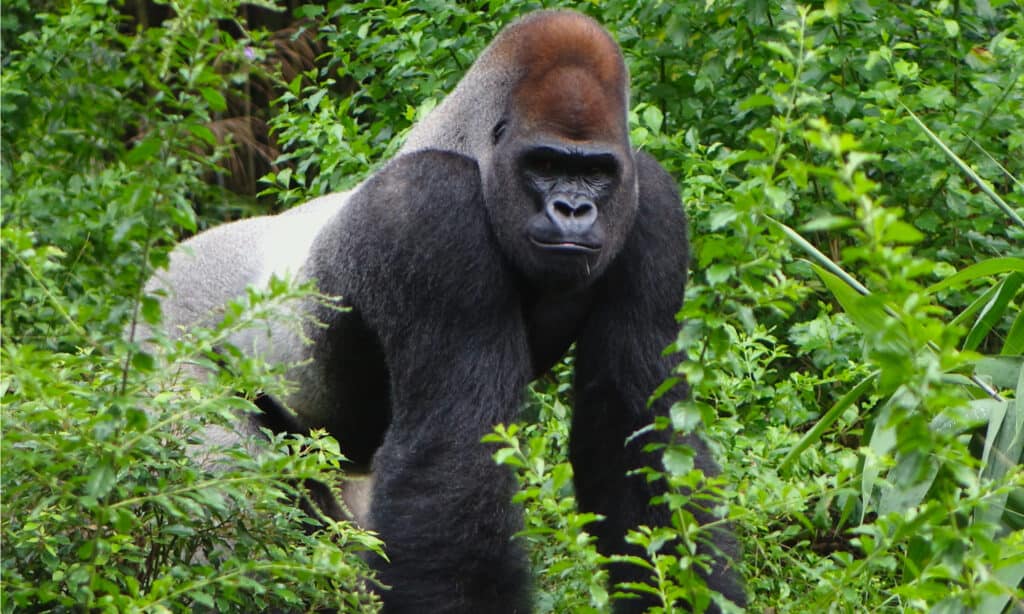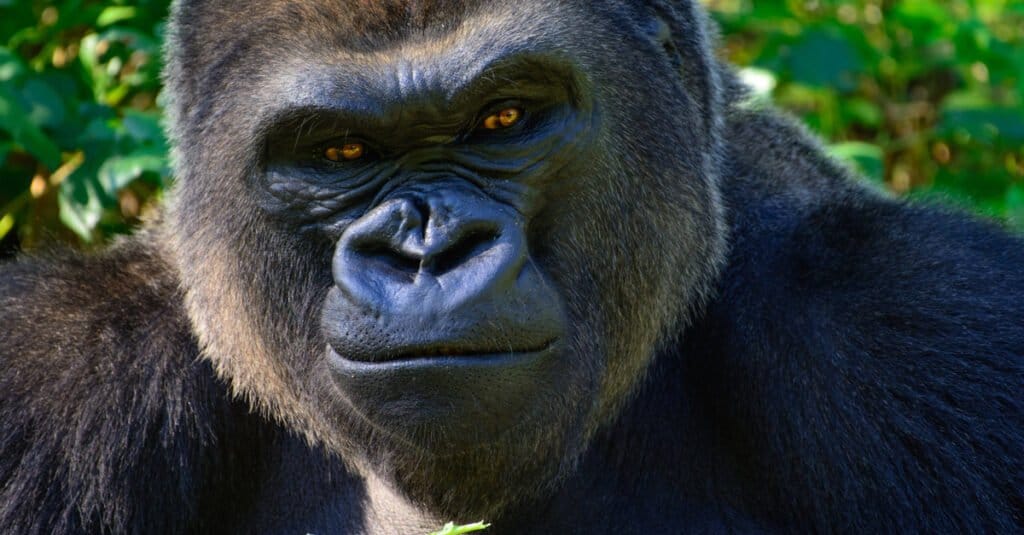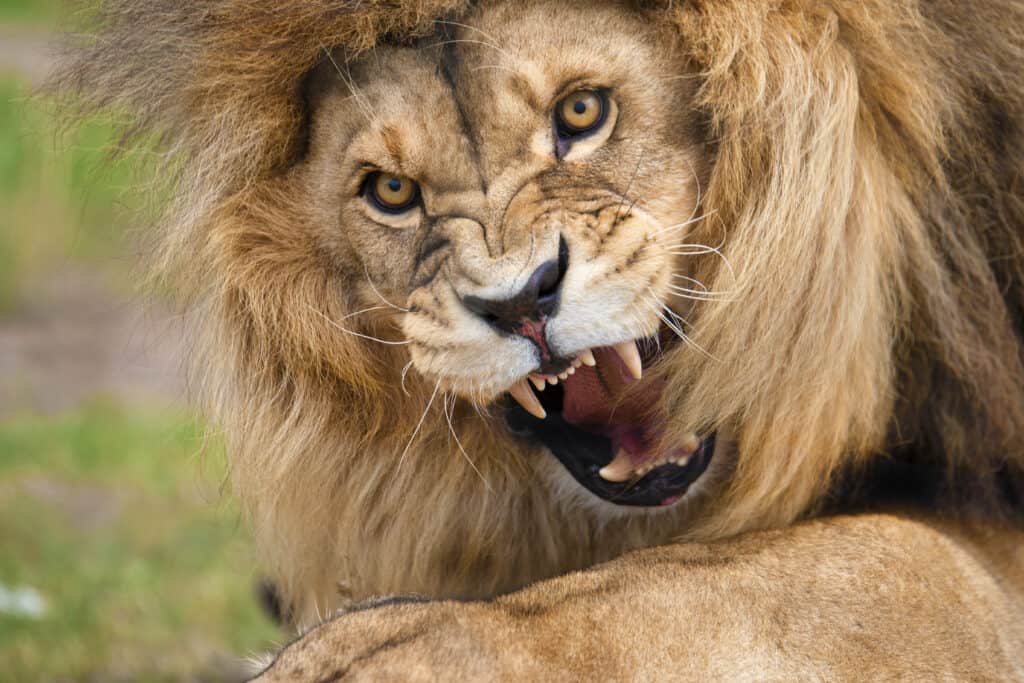Humans have extensively studied various primates in an attempt to better understand the roots of our species. Gorillas are often considered among the closest relatives to modern humans. These African primates are large and share quite a bit of DNA with humans. Yet, they’re not the only unique primates in this part of the world. Today, we’re going to examine a mandrill vs gorilla. You’ll learn about how these two animals have similarities but differ in significant ways.
Comparing a Mandrill and a Gorilla

| Mandrill | Gorilla | |
|---|---|---|
| Size | Weight: 25 to 60 lbs Height: 1.5-2.1 ft | Weight: 220 to 400 lbs Height: 4 to 5.1 ft |
| Morphology | – Long face relative to its head – Have colorful faces, including red and blue – Colorful posterior with red, blue, and purple – Possess a short tail | – Large, heavy body including a thick skull that is elongated at the top – Have dark colors like brown, black, and gray – Have no tail |
| Diet | – Omnivores – Mostly eat plant matter – Will go after the odd bird, small mammal, or frog | – Almost entirely herbivores – Can incidentally eat ants, termites, and other insects on their typical food |
| Location | – West-central Africa – Cameroon, Democratic Republic of the Congo, Equatorial Guinea, and Gabon | – West-central Africa and central Africa – Democratic Republic of Congo, Republic of Congo, Nigeria, Angola, Central African Republic, Rwanda, Uganda, Equatorial Guinea – More widespread due to different species |
| Habitat | – Rainforest – Forested savannahs – Spend large amounts of time in trees | – Lowland tropical forests – Bamboo forests – Live mostly on the ground |
| Phylogenetic Family | – Monkey – Mandrillus sphinx | – Ape – Two species – Gorilla gorilla and Gorilla beringei |
The 6 Key Differences Between a Mandrill vs Gorilla

Gorillas live mostly on the ground.
©CXI/Shutterstock.com
The greatest differences between a mandrill and a gorilla lie in their morphology and size. Gorillas can range in size from 4 to 5.1 ft tall and weigh between 220 and 400 lbs on average while having a dark-colored and thickly set body and head and no tail. Mandrills only weigh up to 60 lbs on average and stand just 2.1 ft tall while having a colorful face and posterior, a long face, and a short tail.
These are major differences that can help you tell the differences between the species at a glance. Yet, these characteristics are not the only way to tell these animals apart. Let’s take an even closer look at what separates them.
Mandrill vs Gorilla: Size

Mandrills are smaller than gorillas.
Gorillas are larger than mandrills. The average gorilla can weigh anywhere between 220 and 400 lbs when fully grown, but this species can get much larger. The largest gorilla ever recorded weighed 860 lbs, and the largest wild gorilla weighed 589 lbs. These are large, powerful creatures in contrast to the mandrill.
The mandrill is a relatively small monkey that weighs between 25 and 60 lbs and stands 2.1 ft tall. These animals are very diminutive next to a gorilla.
Mandrill vs Gorilla: Morphology
The mandrill and gorilla have unique bodies with many dissimilarities aside from size. For example, the mandrill is a colorful animal. Its face and posterior have colors such as red and blue, with some areas blending into purple. These colors become more pronounced when the animal is excited.
However, the mandrill is also known for its fur colors that include gray, grayish blue, brown, black, and a light tan color. Lastly, mandrills have tails, and gorillas do not.
The gorilla is a dark animal for the most part. Their faces are black, and they are known for having dark colors like brown and black in their fur. However, older males do begin to gray as they age, hence the name silverback being attached to them.
Mandrill vs Gorilla: Diet
Gorillas are primarily herbivorous, but they are technically incidental omnivores. They eat a lot of plant matter, but they will also eat termites, ants, and other insects that happen to be living on their food of choice at the time it is picked up.
Mandrills are true omnivores that eat various plants and fruit as well as small birds, mammals, and amphibians. Still, the vast majority of their diet comes from plants.
Mandrill vs Gorilla: Location
Mandrills and gorillas have a location that overlaps with each other to a degree, but gorillas are more widespread. The mandrill range includes west-central Africa in countries like Cameroon, the Democratic Republic of the Congo, Equatorial Guinea, and Gabon.
Gorillas live in west-central and central Africa in places like the Democratic Republic of Congo, Republic of Congo, Nigeria, Angola, Central African Republic, Rwanda, Uganda, and Equatorial Guinea. Overall, gorillas are more widespread.
Mandrill vs Gorilla: Habitat
Gorillas tend to live in lowland tropical forests, some mountainous areas, and bamboo forests. These primates live mostly on the ground with a small amount of their day spent in trees searching for fruits. However, mandrills spend a lot of time in trees, and they prefer to live in rainforests and forested savannahs.
Mandrill vs Gorilla: Phylogenetic Family
The mandrill’s scientific name is Mandrillus sphinx, and they are monkeys. However, gorillas are apes, and they have two species, Gorilla gorilla and Gorilla beringei.
Although these two animals share a range in some places, they are distinct from each other at a very basic level.
Mandrill vs Gorilla: Who Would Win in a Fight?

Gorillas are too strong for most other primates to attack.
©Jeff W. Jarrett/Shutterstock.com
A gorilla would win a fight against a mandrill without much effort. When provoked to anger, gorillas become fierce creatures that show off their strength, speed, agility, and intelligence by systematically maiming their foes. They are much stronger than mandrills, and they have a massive size advantage where they can be over five times their size.
They could pummel the mandrill to death, but the more likely scenario is biting to the head while tearing at the smaller creature’s body. The mandrill would stand basically no chance against the massive, roaring gorilla.
Meanwhile, the mandrill could only fight back against the gorilla by biting or fleeing. Even if they fled, gorillas are very quick and can give chase into the trees that the monkeys use to escape some predators. In the end, the gorilla wins this battle.
What Animal Can Take Down a Gorilla?

Lions are renowned for their ferocity and agility as well as their skill in taking on bigger opponents and hunting as a group
©Shawn Levin/Shutterstock.com
A pride of lions is pretty capable of handling this powerful primate, its immense strength notwithstanding.
There is no doubt that gorillas’ maximum weight of 586 lbs and their ability to heft 1,800 lbs is nothing short of impressive. The fact that they also have pretty formidable fangs with a bite force which at 1,300 psi is precisely twice a lion’s which is only 650 psi, is another factor which weighs in their favor.
However, the gorilla would sustain serious injury against a single lion. After all, it would be facing a maximum potential weight of 550 lbs (pretty close to its own) of natural feline agility and ferocity. Not to mention claws and fangs.
What’s more, lions rarely hunt alone. And while the gorilla might be able to deal damage to at least one adversary, it would simply be outmatched by the rest.
The photo featured at the top of this post is © Nikolay 007/Shutterstock.com
Thank you for reading! Have some feedback for us? Contact the AZ Animals editorial team.






